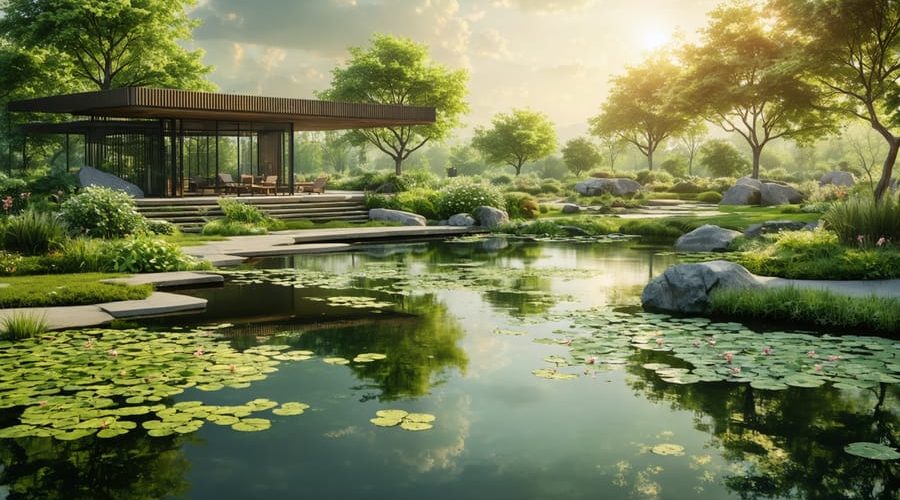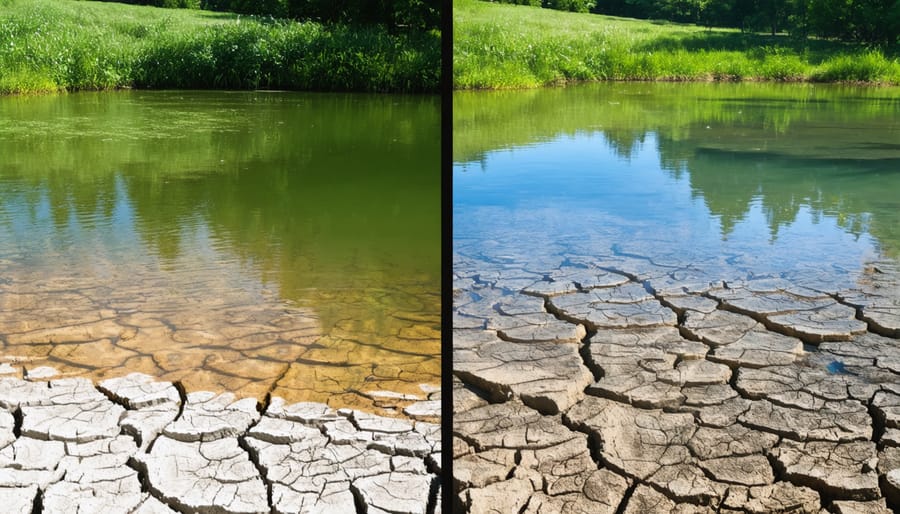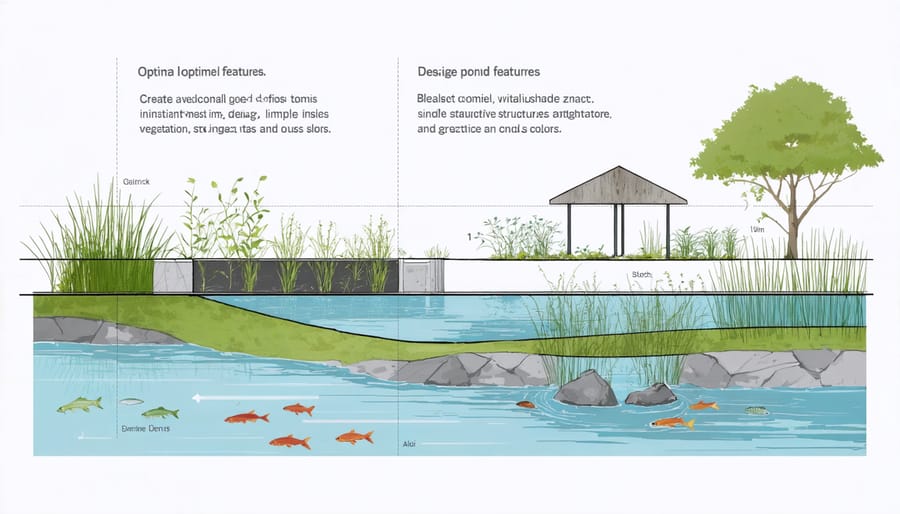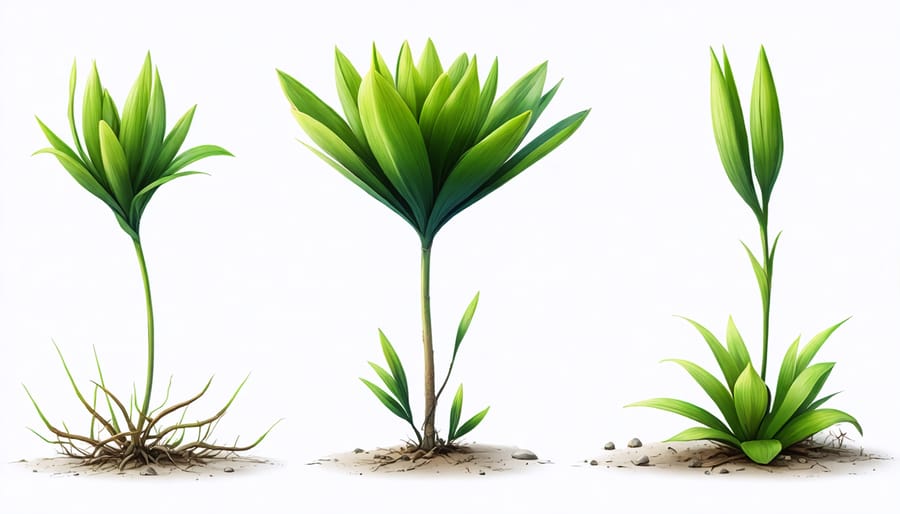
Save Your Pond: Smart Solutions for Global Warming’s Water Crisis
Climate change and prolonged drought periods pose serious challenges for pond owners, threatening water levels, ecosystem balance, and the overall health of aquatic environments. Rising temperatures accelerate evaporation rates, while decreased rainfall creates a double threat to water features that many traditional seasonal pond maintenance approaches fail to address.
Install shade sails or strategically plant native trees around your pond to reduce water temperature and minimize evaporation. Create deeper sections within your pond (at least 2-3 feet) to maintain stable water temperatures and provide fish with cool refuges during extreme heat. Implement a water recycling system that captures and filters rainwater to replenish pond levels naturally, reducing reliance on municipal water sources.
Modern pond management requires adapting to these changing climate patterns with smart design choices and proactive maintenance strategies. By understanding the connection between global warming and local water challenges, pond owners can take meaningful steps to protect their aquatic sanctuaries while contributing to broader water conservation efforts.
This pressing environmental challenge demands immediate action, but with proper planning and sustainable solutions, it’s possible to maintain thriving water features even in increasingly challenging conditions.

How Global Warming Affects Your Water Garden
Temperature Impact on Pond Life
As water temperatures rise, pond life faces significant challenges. Fish become more stressed and require more oxygen, while their metabolism speeds up, making them hungrier and more active. You might notice your fish gasping at the surface or clustering near waterfalls where oxygen levels are higher.
Pond plants also struggle in warmer conditions. While some aquatic plants thrive in heat, others may show signs of stress through yellowing leaves or stunted growth. Algae, unfortunately, loves warm water and can bloom rapidly, creating additional problems for your pond ecosystem.
The beneficial bacteria that help maintain water quality are particularly sensitive to temperature changes. These microscopic helpers work less efficiently in warm water, potentially leading to ammonia buildup and poor water quality. When temperatures consistently stay above 75°F (24°C), these bacterial colonies may start to decline.
To help your pond life adapt, consider adding floating plants for shade, maintaining consistent water levels, and ensuring your aeration system is working properly. Remember, a healthy pond ecosystem is more resilient to temperature fluctuations.
Water Loss and Evaporation Challenges
As our climate continues to warm, pond owners face increasing challenges with water loss through evaporation. Hot temperatures and dry winds can cause water to evaporate much faster than usual, leading to dropping water levels and potential stress on pond life. On particularly hot days, a typical garden pond can lose up to an inch of water through evaporation alone.
This increased evaporation isn’t just about losing water – it also concentrates dissolved minerals and nutrients in the remaining water, which can affect water quality and potentially harm fish and plants. When water evaporates, it leaves behind everything that was dissolved in it, making the pond water increasingly concentrated.
To combat these challenges, consider installing a pond with greater depth (at least 2 feet) to create a larger water volume that’s more resistant to temperature fluctuations. Adding floating plants can help shade the water surface and reduce evaporation rates. Regular monitoring of water levels and quality becomes especially important during hot spells, and having an automatic top-up system can help maintain consistent water levels. Remember that prevention is often easier than correction when it comes to water loss issues.
Drought-Smart Design Solutions
Depth and Shape Optimization
When designing or modifying your pond to combat water loss during drought conditions, proper depth and shape considerations are crucial. The ideal pond depth varies depending on your climate, but generally, deeper ponds retain water better and maintain more stable temperatures. For most natural water features, aim for a minimum depth of 2 feet, with deeper sections of 3-4 feet where possible.
Shape matters just as much as depth. A bowl-shaped design with graduated slopes helps reduce water loss through evaporation by decreasing the surface area relative to volume. Avoid shallow shelves and extensive shallow areas, which increase evaporation rates and heat up quickly. Instead, incorporate steep sides with a gentle slope from the edges to the deepest point.
Consider creating different depth zones within your pond. The deepest zone should occupy about 60% of the total area, providing a stable environment during extreme weather. Include a mid-depth zone (1-2 feet) for aquatic plants, and limit shallow areas to just what’s necessary for marginal plants and visual appeal.
For additional protection, incorporate overhanging edges or partially shaded areas into your design. These features not only add visual interest but also reduce direct sunlight exposure and evaporation. If you’re building a new pond, consider orienting it to minimize exposure to prevailing winds, which can increase water loss through evaporation.
Remember to balance aesthetics with practicality – while a deeper pond is more drought-resistant, ensure it still fits harmoniously within your landscape design and meets your maintenance capabilities.

Shade and Cover Strategies
Creating effective shade over your water features is one of the best ways to reduce evaporation and protect your pond during hot, dry periods. Natural shade solutions are often the most attractive and environmentally friendly options. Consider planting tall marginal plants around the edges of your pond, such as cattails or iris, which provide both shade and natural beauty. Floating plants like water lilies and lotus not only add visual interest but also cover the water surface, significantly reducing evaporation.
For larger ponds, strategically placed trees can offer excellent shade coverage. However, be mindful to plant them far enough away to prevent excess leaf litter from falling into the water. Fast-growing varieties like river birch or weeping willow work well, but ensure their root systems won’t interfere with your pond liner.
If natural solutions aren’t practical, artificial shade structures can be equally effective. Shade sails are popular choices, offering customizable coverage and modern aesthetics. They’re easy to install and can be removed during cooler months. Pergolas with climbing vines provide a more permanent solution while creating an attractive outdoor living space.
For smaller water features, portable umbrellas or retractable awnings offer flexible shade options that can be adjusted as the sun moves throughout the day. Even simple solutions like floating shade balls or covers can make a significant difference in reducing water loss through evaporation.
Remember to monitor your pond’s exposure to sunlight throughout the day when planning your shade strategy. The goal is to provide coverage during the hottest parts of the day while still allowing enough light for aquatic plants to thrive.
Water-Wise Maintenance Practices
Smart Water Management
Water conservation doesn’t have to be complicated – small changes in our daily habits can make a big difference. Start by installing water-efficient fixtures like low-flow showerheads and dual-flush toilets, which can reduce household water usage by up to 50%. In your garden, consider switching to drip irrigation systems that deliver water directly to plant roots, minimizing waste through evaporation.
Rainwater harvesting is another smart solution that’s gaining popularity. Setting up rain barrels or larger collection systems can provide free water for your garden and help reduce stormwater runoff. For lawn care, adjust your mowing height to 3 inches or higher – taller grass develops deeper roots and requires less frequent watering.
Monitor your water usage regularly and fix leaks promptly. Even a small drip can waste hundreds of gallons monthly. Consider installing smart water meters that alert you to unusual consumption patterns or potential leaks. For outdoor spaces, group plants with similar water needs together (known as hydrozoning) and use mulch generously to retain soil moisture.
Gray water recycling systems can help you reuse water from sinks and washing machines for irrigation. While initial setup costs may be higher, these systems typically pay for themselves through reduced water bills. Remember to water your garden early morning or late evening when evaporation rates are lowest, and always check weather forecasts to avoid watering before rainfall.
Plant Selection and Care
When selecting plants for your water garden in these challenging times, focus on species that can handle fluctuating water levels and intense heat. Native aquatic plants often prove more resilient than exotic varieties, having naturally adapted to local climate conditions. Consider hardy options like cattails, rushes, and sedges, which can thrive even when water levels drop.
For shallow areas and margins, opt for moisture-loving plants that can tolerate occasional dry spells, such as marsh marigolds, cardinal flowers, and iris. These plants develop deep root systems that help them survive during drought periods while adding beautiful color to your pond’s edges.
To maintain your aquatic plants during drought conditions, follow these essential care tips:
1. Mulch heavily around marginal plants to retain moisture
2. Group plants with similar water needs together
3. Create deeper planting pockets that stay wet longer
4. Monitor water levels daily during heat waves
5. Consider installing shade cloth during extreme heat
Remember to avoid over-fertilizing, as this can stress plants during drought conditions. Instead, focus on building healthy soil in planting areas and maintaining proper water depth for submerged species. Remove dead or yellowing foliage promptly to prevent water quality issues and reduce evaporation stress on remaining healthy growth.
For container water gardens, choose drought-smart varieties like water lilies and lotus, which can adapt to lower water levels while providing essential cover that reduces evaporation.

Fish Care During Heat Waves
During heat waves, fish become particularly vulnerable to stress and oxygen depletion. Just like protecting pond life in winter, summer demands special attention to keep your finned friends healthy and happy.
First, monitor water temperature regularly, ideally in the early morning and late afternoon. If temperatures rise above 80°F (27°C), take immediate action. Add extra aeration through air stones or fountains, as warm water holds less oxygen. Position these near the surface where oxygen exchange is most effective.
Create shaded areas using floating plants like water lilies or install shade sails above your pond. This natural cooling method can reduce water temperature by several degrees. During extreme heat, consider running your fountain or waterfall 24/7 to maintain oxygen levels and cooling water movement.
Feed your fish less frequently during heat waves, as their metabolism changes with temperature. Offer small portions in the cooler morning hours when oxygen levels are highest. Watch for signs of stress like gasping at the surface or lethargy, which indicate immediate intervention is needed.
Keep backup battery-operated air pumps ready in case of power outages. If necessary, use a garden hose to add fresh water gradually, creating a cooling effect. Just remember to dechlorinate any new water before adding it to your pond.
Emergency Drought Response
When drought conditions hit, quick action can help protect your pond and its inhabitants. Start by immediately reducing water loss through evaporation by adding floating plants to cover about 60% of the surface area. These plants not only shade the water but also help maintain oxygen levels.
Install a pond net or shade sail above your pond to provide additional protection from intense sun and heat. This simple addition can significantly reduce water temperature and evaporation rates. If you haven’t already, check and repair any leaks in your liner or plumbing system – even small leaks can compound drought issues.
Monitor water levels daily and top up as needed, preferably during early morning or evening hours to minimize evaporation. Consider installing a water storage system to collect rainwater when available, ensuring you have a backup water supply during dry spells.
Reduce feeding frequency for fish, as higher temperatures increase metabolism but also decrease oxygen levels. Remove any dying plant material promptly to prevent decomposition from further depleting oxygen. If possible, add an additional air pump or fountain to increase oxygen circulation, especially during the hottest parts of the day.
In severe cases, you may need to temporarily reduce the pond’s water level to concentrate on maintaining essential areas. Keep your biological filtration running but consider turning off waterfalls or streams to reduce water loss. Remember to keep your pump intake submerged to prevent damage.
Stay vigilant for signs of stress in fish and plants, such as gasping at the surface or wilting leaves, and be prepared to take immediate action if these symptoms appear.
As pond owners, we’re facing new challenges in this changing climate, but there’s no need to feel overwhelmed. By implementing the strategies we’ve discussed, you can keep your pond thriving even during extended dry spells. Remember to focus on water conservation through proper design, including deeper pond construction and strategic plant placement for shade. Installing a reliable pump system and maintaining proper filtration will help your pond stay healthy with less water waste.
Don’t wait for drought conditions to strike – start adapting your pond now. Simple steps like adding floating plants, installing rain barrels, and regularly checking for leaks can make a big difference. Monitor your local weather patterns and adjust your maintenance routine accordingly. Consider joining local gardening groups to share experiences and solutions with fellow pond enthusiasts.
With thoughtful planning and proactive maintenance, your pond can remain a beautiful and sustainable feature of your garden, even as our climate continues to change. Stay informed, be adaptable, and remember that small changes today can help protect your pond for years to come.
